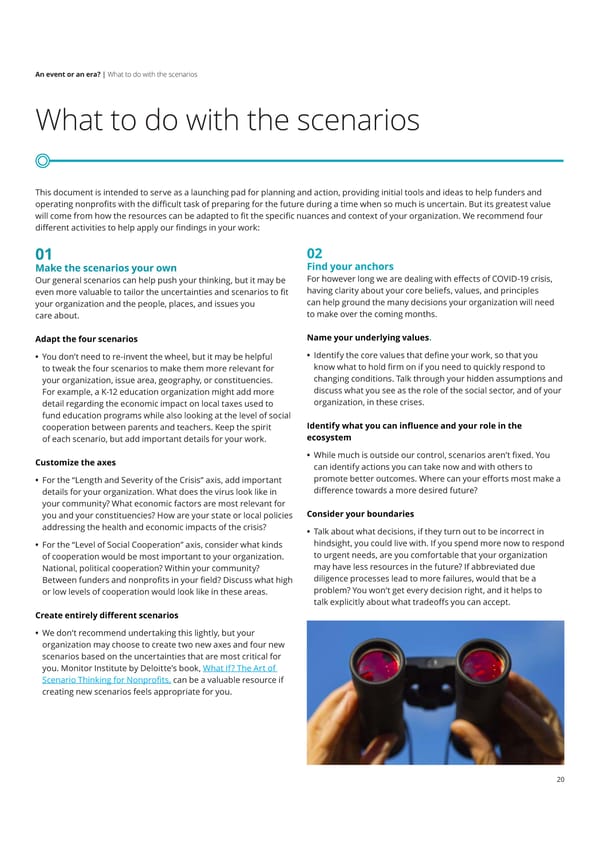An event or an era? | What to do with the scenarios What to do with the scenarios This document is intended to serve as a launching pad for planning and action, providing initial tools and ideas to help funders and operating nonprofits with the difficult task of preparing for the future during a time when so much is uncertain. But its greatest value will come from how the resources can be adapted to fit the specific nuances and context of your organization. We recommend four different activities to help apply our findings in your work: 01 02 Make the scenarios your own Find your anchors Our general scenarios can help push your thinking, but it may be For however long we are dealing with effects of COVID-19 crisis, even more valuable to tailor the uncertainties and scenarios to fit having clarity about your core beliefs, values, and principles your organization and the people, places, and issues you can help ground the many decisions your organization will need care about. to make over the coming months. Adapt the four scenarios Name your underlying values. • You don’t need to re-invent the wheel, but it may be helpful • Identify the core values that define your work, so that you to tweak the four scenarios to make them more relevant for know what to hold firm on if you need to quickly respond to your organization, issue area, geography, or constituencies. changing conditions. Talk through your hidden assumptions and For example, a K-12 education organization might add more discuss what you see as the role of the social sector, and of your detail regarding the economic impact on local taxes used to organization, in these crises. fund education programs while also looking at the level of social cooperation between parents and teachers. Keep the spirit Identify what you can influence and your role in the of each scenario, but add important details for your work. ecosystem Customize the axes • While much is outside our control, scenarios aren’t fixed. You can identify actions you can take now and with others to • For the “Length and Severity of the Crisis” axis, add important promote better outcomes. Where can your efforts most make a details for your organization. What does the virus look like in difference towards a more desired future? your community? What economic factors are most relevant for you and your constituencies? How are your state or local policies Consider your boundaries addressing the health and economic impacts of the crisis? • Talk about what decisions, if they turn out to be incorrect in • For the “Level of Social Cooperation” axis, consider what kinds hindsight, you could live with. If you spend more now to respond of cooperation would be most important to your organization. to urgent needs, are you comfortable that your organization National, political cooperation? Within your community? may have less resources in the future? If abbreviated due Between funders and nonprofits in your field? Discuss what high diligence processes lead to more failures, would that be a or low levels of cooperation would look like in these areas. problem? You won’t get every decision right, and it helps to talk explicitly about what tradeoffs you can accept. Create entirely different scenarios • We don’t recommend undertaking this lightly, but your organization may choose to create two new axes and four new scenarios based on the uncertainties that are most critical for you. Monitor Institute by Deloitte’s book, What If? The Art of Scenario Thinking for Nonprofits, can be a valuable resource if creating new scenarios feels appropriate for you. 20
 US Deloitte Monitor Institute Page 19 Page 21
US Deloitte Monitor Institute Page 19 Page 21